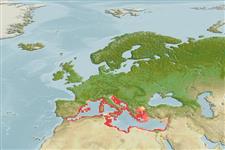Hexacorallia |
Scleractinia |
Dendrophylliidae
Environment: milieu / climate zone / djupintervall / distribution range
Ekologi
Revassocierade; djupintervall 2 - 70 m (Ref. 107521). Subtropical
Western Indian Ocean, Atlantic and the Mediterranean.
Length at first maturity / Size / Weight / Age
Könsmognad: Lm ? range ? - ? cm
Known from circalittoral zones (Ref. 85338). Believed to be a warm water species with narrow temperature tolerance (Ref. 115189). Common azooxanthellate, generally in shaded habitats, below overhangs or cave entrances (Ref. 107537). In fissures of rocky shores. Appears in two forms: the flat one lives in shallow waters while the turf shape lives in deeper waters, caves, and slopes (Ref. 115189).
Life cycle and mating behavior
Könsmognad | Reproduktion | Lek | Eggs | Fecundity | Larvae
Members of the class Anthozoa are either gonochoric or hermaphroditic. Mature gametes are shed into the coelenteron and spawned through the mouth. Life cycle: The zygote develops into a planktonic planula larva. Metamorphosis begins with early morphogenesis of tentacles, septa and pharynx before larval settlement on the aboral end.
Vafidis, D. 2010 Checklist of class Anthozoa (Phylum Cnidaria). In Coll, M., et al., 2010. The biodiversity of the Mediterranean Sea: estimates, patterns, and threats. PLoS ONE 5(8):36pp. (Ref. 85338)
IUCN Red List Status
(Ref. 130435: Version 2025-1)
CITES status (Ref. 108899)
Not Evaluated
Threat to humans
Human uses
| FishSource |
Verktyg
Ytterligare information
Trophic EcologyFood items (preys)
Födosammansättning
Födointag
Predatorer
Population dynamicsTillväxt
Max. ages / sizes
Length-weight rel.
Length-length rel.
Length-frequencies
Mass conversion
Abundans
PhysiologySyreförbrukning
Human RelatedStamps, coins, misc.
Internet-källor
Estimates based on models
Preferred temperature
(Ref.
115969): 16.9 - 19.6, mean 19.1 (based on 14 cells).
Price category
Unknown.
